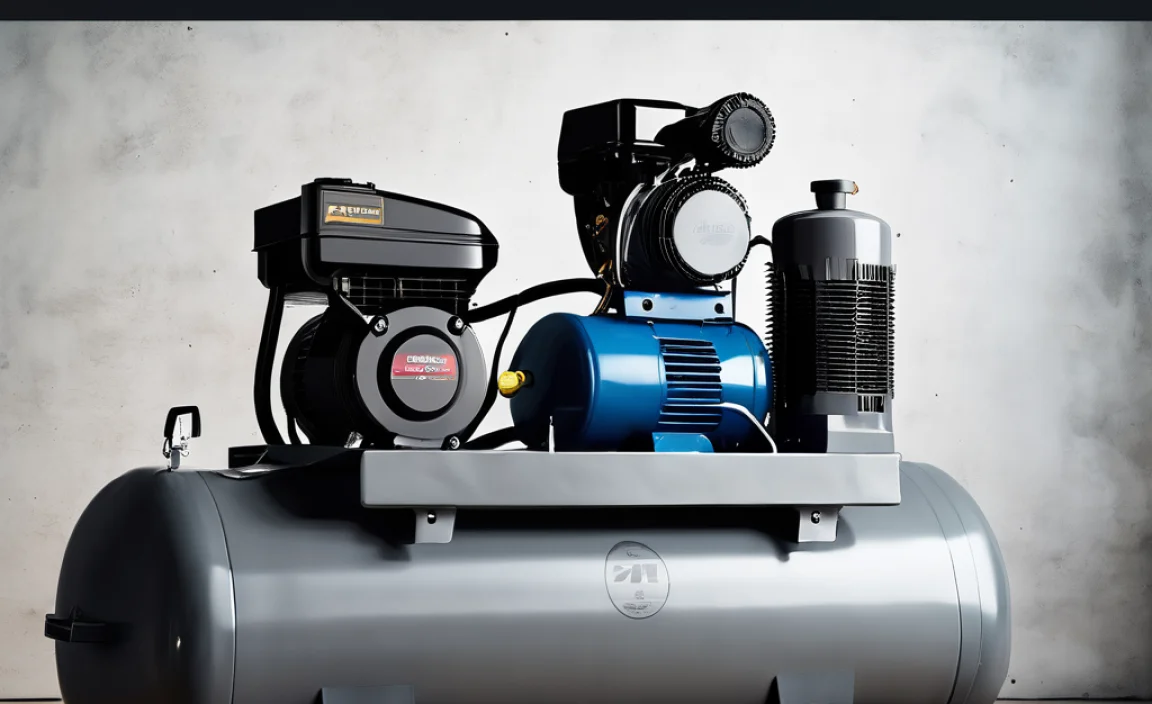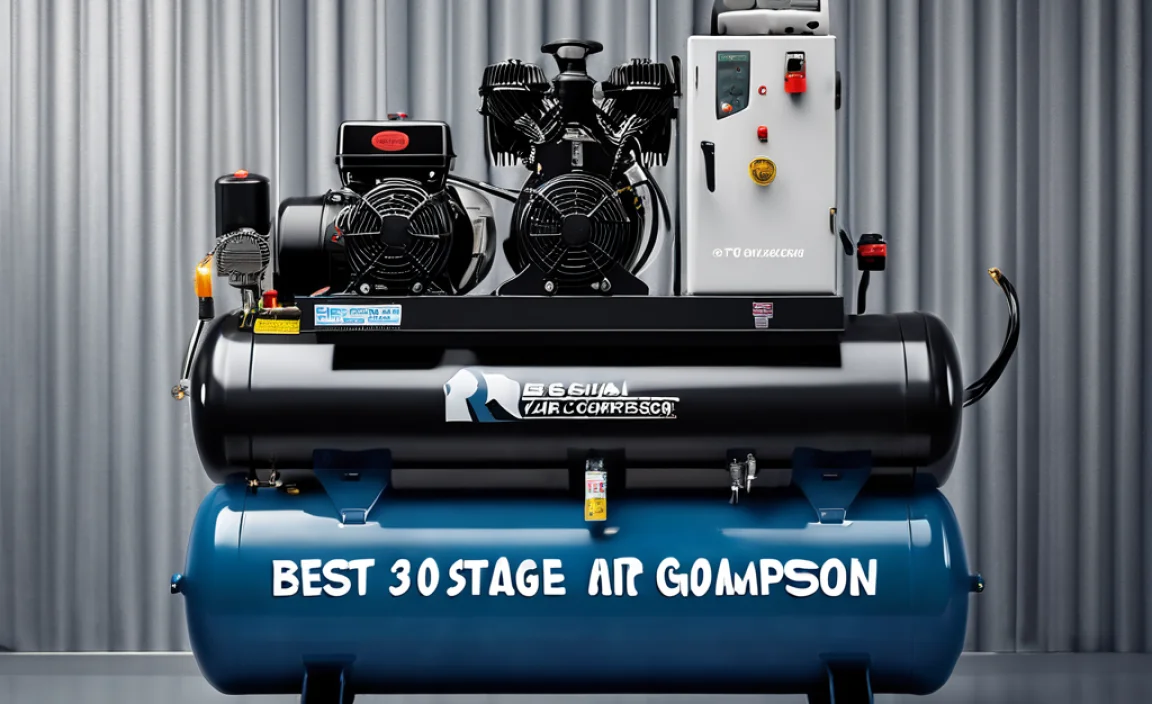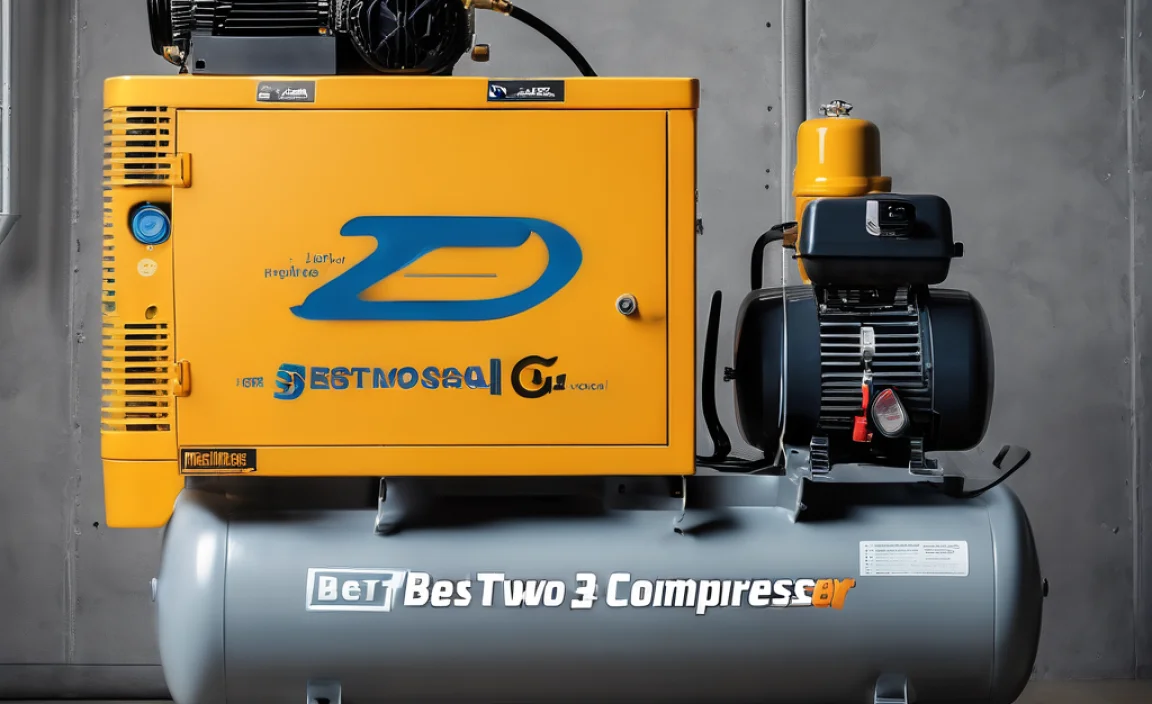Hey there! Let’s talk about air compressors. It can feel like a puzzle trying to find the right one, especially when you need a good amount of air for bigger DIY projects. You want something powerful yet reliable, right? Don’t worry! We’ll break down what makes a two-stage, 30-gallon air compressor a fantastic choice for homeowners and hobbyists. We’ll explore why it’s the sweet spot for power and capacity, and how to pick the perfect one for your garage or workshop. Get ready to power up your projects!
Tackling Big Projects: Why a 30-Gallon, Two-Stage Compressor is Your New Best Friend

Ever stared at a project and thought, “Man, I wish I had more power here”? That’s where a good air compressor comes in. For many of us tackling DIY home improvements, car maintenance, or even just keeping up with hobbies, a standard compressor just doesn’t cut it anymore. You need something that can keep up with demanding tools like impact wrenches, sanders, or spray painters without sputtering out. That’s why so many folks are turning to the two-stage, 30-gallon air compressor. It’s like the workhorse of the compressor world, offering a great balance of power, storage, and run-time that makes a huge difference.
What in the World is “Two-Stage” and “30 Gallon”?
Let’s break down those terms. You’ll see “30 gallon” and “two-stage” all over the place when looking for a compressor. Think of the 30 gallons as the size of the air tank. This is how much compressed air the compressor can store. A bigger tank means you can run your air tools for longer before the compressor has to kick back on to refill it. This is super important if you’re using tools that need a continuous supply of air, like a sander or a paint sprayer.
Now, “two-stage” refers to how the compressor compresses the air. In a two-stage compressor, the air is compressed once, cooled down a bit, and then compressed a second time. This makes it much more efficient and allows the compressor to reach higher pressures (PSI) and deliver more air volume (CFM) consistently compared to a single-stage compressor. This means your tools will run stronger and longer, making your work faster and easier. It’s a win-win!
Why This Size and Type is Perfect for Homeowners and Serious Hobbyists
So, why is this specific combination—30 gallons and two-stage—the “sweet spot” for so many? Let’s think about it:
- Power for the Pros (and the Enthusiasts): Two-stage compressors are built for continuous, demanding use. They can easily power tools that require a lot of cubic feet per minute (CFM) of air. This means your impact wrench won’t bog down when you’re loosening a stubborn lug nut, and your paint sprayer will give a smooth, consistent finish.
- Run Time is King: With a 30-gallon tank, you get a substantial reserve of air. For DIY tasks that aren’t constant but require bursts of power, like using nail guns or staplers, this tank size means you’ll be refilling the tank less often. Less waiting, more doing!
- Versatility is Key: This setup handles a wide range of tasks. From basic tire inflation and powering air ratchets for car repair to running more demanding tools like die grinders or even small sandblasters, a 30-gallon two-stage compressor is incredibly versatile.
- Durability and Reliability: Two-stage compressors are generally built to last. They often have cast-iron cylinders and better cooling systems, which means they can handle more work over a longer lifespan. This makes it a great investment for your home workshop.
When you’re looking for that perfect blend of performance and capacity for your workshop, the 30-gallon, two-stage air compressor really shines. It’s an upgrade from smaller units and provides the muscle you need without going overboard.
What Makes a “Best” Two-Stage 30 Gallon Air Compressor? Key Features to Look For

Finding the “best” 30-gallon, two-stage air compressor isn’t just about picking the flashiest one. It’s about understanding what features will make it work best for you and your projects. Think of it like choosing the right tool from your toolbox – you need the one that’s built for the job. Here are the key things to keep your eyes peeled for:
1. CFM: The True Measure of Air Delivery
This is probably the most important number you’ll see besides the tank size. CFM stands for Cubic Feet per Minute, and it tells you how much air the compressor can deliver at a specific pressure. Most tools will list their CFM requirement. You want a compressor that delivers at least 1.5 to 2 times the CFM your most demanding tool needs. This ensures your tool runs at its best and the compressor isn’t constantly straining.
Why it matters: If your compressor’s CFM is too low for your tool, the tool will perform poorly, or worse, not work at all. For example, a sander needs a good, steady flow of air to operate effectively. A compressor that can’t keep up will lead to slow sanding and frustrating results.
Where to find it: Look for CFM ratings at 90 PSI. This is the industry standard for comparing compressors and their ability to power tools. A good two-stage 30-gallon compressor will typically offer 4-6 CFM at 90 PSI, sometimes even more.
2. Horsepower (HP) vs. Actual Horsepower (AHP)
You’ll see two numbers for horsepower: advertised and actual. Advertised HP (often called “peak” or “max” HP) is like the peak speed of a car – exciting but not what you can sustain. Actual Horsepower (AHP), sometimes also called “running HP” or “continuous HP,” is the better indicator of sustained power output. It reflects the motor’s ability to do work over time. Aim for a compressor with a solid AHP. A 3 to 5 AHP motor is a good range for most 30-gallon, two-stage units. Don’t get too hung up on the high advertised numbers alone!
3. Pump Type: What’s Inside Matters
When we talk about the pump in a two-stage compressor, you’ll often see references to its construction. The most durable and efficient pumps are typically made with cast iron. Cast iron pumps dissipate heat better and are more robust, meaning they’ll last longer under heavy use. Look for terms like “cast iron pump” or “oil-lubricated cast iron pump.” These are designed for longevity and consistent performance, perfect for those who plan on using their compressor for years to come.
4. Tank Size and Configuration
We’ve already covered the 30-gallon part, which is great for extended run times. But also consider the tank’s design. Most 30-gallon tanks are vertical (standing up). This is fantastic for saving floor space in a garage or workshop. Horizontal tanks take up more room but can be easier to access for draining.
Look for:
- Drain Valve Accessibility: A ball valve drain at the bottom of the tank is much easier to use than a petcock valve. You’ll want to drain condensate regularly to prevent rust. Some higher-end units have automatic drain valves, which is a nice perk.
- Pressure Gauge: Clear, easy-to-read gauges for tank pressure and regulated output pressure are essential.
- Regulator: A good quality regulator allows you to set the exact air pressure needed for your specific tool.
5. Noise Level: Your Ears Will Thank You
Air compressors can be loud. If your workshop is attached to your house or you have neighbors close by, noise level is a big concern. Look for compressors that advertise lower decibel (dB) ratings. Some manufacturers also use features like enclosed pump/motor housings or special mufflers to reduce noise. While a two-stage unit by nature is more powerful and can be louder, many brands offer quieter models. This is a premium feature, but if it’s important to you, it’s worth the research.
6. Duty Cycle: How Often Can It Run?
The duty cycle tells you how long the compressor can run within a given period before needing to cool down. It’s usually expressed as a percentage. For example, a 75% duty cycle means the compressor can run for 7.5 minutes out of every 10 minutes. For a two-stage compressor, especially one with a good cooling system, you’ll often find duty cycles of 75% to 100% (meaning it can run continuously). This is another indicator of a robust, heavy-duty unit designed for prolonged use.
7. Portability (or Lack Thereof)
While 30-gallon compressors are on the larger side, some are designed with wheels and handles to be moved around a garage or driveway. Others are stationary units meant to be installed in a dedicated spot. The “best” depends on your needs. If you plan to move it often, look for sturdy wheels and good weight distribution. If it’ll stay put, a more robust, potentially heavier, stationary unit might offer better vibration dampening.
By keeping these features in mind, you can cut through the marketing and find a 30-gallon, two-stage air compressor that truly fits your DIY needs and budget, ensuring you get a reliable tool that will serve you for years.
Top Picks: The Best Two-Stage 30 Gallon Air Compressors for DIYers

Alright, let’s get down to business! When you’re ready to invest in a solid 30-gallon, two-stage air compressor, you want to know what’s out there that’s reliable and delivers on its promises. While “best” can be subjective and depend on your exact budget and needs, here are a few types and brands that consistently get high marks from DIYers for their performance, durability, and value. We’ll look at what makes each stand out.
Category: Premium Powerhouse
These are the heavy hitters, often costing a bit more but delivering top-tier performance for those who demand the best. They’re built for serious, continuous use.
- Brand Example: Ingersoll Rand, Quincy Compressor, Sullair (often seen in professional settings, but smaller models are great for serious home use)
- What to Look For in This Category:
- Very high CFM ratings (often 5+ CFM at 90 PSI)
- Extended warranties (5 years or more)
- Superior build quality, often with higher-grade cast iron components
- Lower noise levels for their power class
- Potentially higher horsepower (consistent running HP, not just peak)
- Why Choose This: If you’re running multiple high-demand tools simultaneously, have a dedicated workshop, and want a compressor that will last a lifetime, this is the category for you. They offer incredible reliability and power reserves.
Category: Best Value Workhorse
This category is where many DIYers find their sweet spot. You get excellent performance and durability without breaking the bank. They are built for demanding home garage use.
- Brand Example: Husky, Kobalt, Campbell Hausfeld (specific models), DeWalt (certain lines)
- What to Look For in This Category:
- Solid CFM ratings (4-5.5 CFM at 90 PSI)
- Cast iron pump construction
- Good warranties (2-5 years)
- Durable motors with decent AHP
- Often feature vertical tanks for space-saving
- Why Choose This: This is for the weekend warrior, the home mechanic, and the serious hobbyist who needs reliable power for a wide range of tasks but doesn’t need industrial-grade continuous operation. You get fantastic bang for your buck here.
Category: Space-Saving Champion
For those with limited garage space, these compressors offer the power of a 30-gallon, two-stage unit but with a more compact footprint, usually via the vertical tank design.
- Brand Example: Many brands offer vertical tank options within their 30-gallon, two-stage lines. It’s more of a design feature than a specific brand niche.
- What to Look For in This Category:
- Vertical tank design (obvious, but key!)
- Stable base to prevent tipping
- Efficient motor and pump for their size
- Easy access to controls and drain valve
- Why Choose This: If floor space is at a premium in your garage, a vertical 30-gallon compressor is a game-changer. You get the air capacity and power without sacrificing valuable workspace.
A Quick Comparison Table:
| Feature | Premium Powerhouse | Best Value Workhorse | Space-Saving Champion |
|---|---|---|---|
| Price Range | $$$$ | $$$ | $$$ – $$$$ |
| CFM at 90 PSI | 5+ CFM | 4 – 5.5 CFM | 4 – 5.5 CFM |
| Durability | Excellent, industrial-grade | Very Good, heavy-duty home use | Very Good, depends on specific model |
| Target User | Prosumer, dedicated hobbyist, light industrial | Serious DIYer, home mechanic, weekend hobbyist | DIYer with limited space |
| Typical Warranty | 5+ years | 2-5 years | 2-5 years |
When making your final choice, always double-check the specific CFM and AHP ratings for the exact model you’re considering. Reading user reviews for the specific model you’re eyeing can also be incredibly helpful. Many reputable retailers and manufacturers provide detailed spec sheets that are invaluable for comparing machines. Remember, the “best” one for you is the one that meets your needs, fits your space, and stays within your budget while offering reliable performance.
Putting Your New Compressor to Work: Essential Steps and Safety First!

So, you’ve picked out your shiny new 30-gallon, two-stage air compressor. Awesome! Now, before you hook up that impact wrench and go to town, let’s get it set up properly and talk about staying safe. It’s not complicated, but a few simple steps make a big difference in how well your compressor performs and how long it lasts. Think of this as breaking in a new pair of work boots – you want them to fit right and last.
Step 1: Unboxing and Inspection
First things first, carefully unbox your compressor. Check for any damage that might have happened during shipping. Make sure you have all the parts listed in the manual. If anything looks off, don’t proceed; contact the seller or manufacturer immediately.
Step 2: Location, Location, Location!
Where you put your compressor matters. You want a spot that’s:
- Well-Ventilated: Compressors generate heat. Good airflow helps keep it cool, which is vital for its longevity and performance. Avoid putting it in a small, enclosed closet unless it has proper ventilation.
- On a Level Surface: This is critical for proper operation and to prevent vibration or tipping. A solid, flat concrete floor is ideal.
- Near a Power Outlet: Make sure you have a dedicated, heavy-duty electrical outlet that can handle the compressor’s power draw. Check your compressor’s manual for the specific voltage and amperage requirements. Using an extension cord is generally not recommended for compressors, as it can lead to voltage drop and damage the motor.
- Away from Flammable Materials: Compressors can get warm, and any spark (though unlikely) could be a hazard.
Step 3: Oil Check (Crucial for Oil-Lubricated Pumps!)
Most two-stage compressors are oil-lubricated. This is key for keeping the pump running smoothly and cool. Before you even think about plugging it in, you’ll need to check the oil level.
How to do it:
- Locate the oil sight glass (it looks like a small window) or the oil dipstick on the pump.
- Ensure the oil level is between the “add” and “full” marks.
- If it’s low, use only the type and weight of oil recommended in your compressor’s manual. Using the wrong oil can damage the pump.
Don’t skip this step! Running a compressor without enough oil will quickly destroy the pump.
Step 4:

I am passionate about home engineering. I specialize in designing, installing, and maintaining heating, ventilation, and air conditioning systems. My goal is to help people stay comfortable in their homes all year long.
